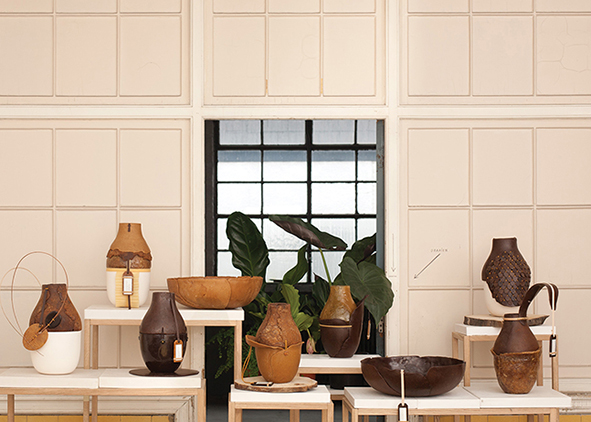Design and ecological thinking. The new narratives of contemporary design placing Earth on centre stage
DOI:
https://doi.org/10.19229/2464-9309/1312023Keywords:
evolutionary design, contextual design, geodesign, restorative design, hyper-objectsAbstract
Transcending design as a blueprint (of an object) to enter the realm of inquiry in an era of climatic and social instability, incorporating knowledge and observing and revealing the phenomena around us from a design perspective: these are all themes addressed by this paper in an attempt to reknit the frayed threads of a discipline frequently called upon to speak of the ecological transition. Recalling Buckminster Fuller, who promoted a practice of design based on rigorous analysis and transparency between both material and user, the design approach of Studio Formafantasma in recent years has been adopted as a paradigm in an alternative to the status quo. With their experimentation, research and, above all, questions, the studio attempts to imagine different futures by revealing the limits of the mannerist creativity embedded in a certain way of thinking about design. In this way, the studio with a documentary-like flair produces information and communication without resigning itself to dominant narratives, nor to the boundaries between species or forms of knowledge.
Article info
Received: 14/04/2023; Revised: 21/04/2023; Accepted: 22/05/2023
Downloads
Article Metrics Graph
References
Antonelli, P. and Tannir A. (eds) (2019), Broken Nature – XXII Triennale di Milano, Electa, Milano.
Coccia, E. (2022), Metamorfosi – Siamo un’unica sola vita, Einaudi, Torino
Croci, V. (2018), “Quando il design è sopravvivenza umana | When Design means Human Survival”, in Domus, n. 1022, pp. 40-47.
Elhacham, E., Ben-Uri, L., Grozovski, J., Bar-On, Y. M. and Milo, R. (2020), “Global human-made mass exceeds all living biomass”, in Nature, vol. 588, pp. 442-444. [Online] Available at: doi.org/10.1038/s41586-020-3010-5 [Accessed 17 May 2023].
European Commission (2021a), Communication from the Commission to the European Parliament, the Council, the European Economic and Social Committee and the Committee of the Regions – Forging a Climate-Resilient Europe – The new EU Strategy on Adaptation to Climate Change, document 52021DC0082, 82 final. [Online] Available at: eur-lex.europa.eu/legal-content/en/ALL/?uri=CELEX:52021DC0082 [Accessed 17 May 2023].
European Commission (2021b), New European Bauhaus – Beautiful, Sustainable, Together. [Online] Available at: europa.eu/new-european-bauhaus/index_en [Accessed 17 May 2023].
European Commission (2020), Recovery Plan for Europe. [Online] Available at: ec.europa.eu/info/strategy/recovery-plan-europe_en [Accessed 17 May 2023].
European Commission (2019), Communication from the Commission to the European Parliament, the European Council, the Council, the European Economic and Social Committee and the Committee of the Regions – The European Green Deal, document 52019DC0640, 640 final. [Online] Available at: eur-lex.europa.eu/legal-content/EN/TXT/?uri=COM%3A2019%3A640%3AFIN [Accessed 17 May 2023].
Formafantasma (ed.) (2021), Cambio, Nero, Roma.
Gould, S. J. and Vrba, E. S. (2008), Exaptation – Il bricolage dell’evoluzione, Bollati Boringhieri, Torino.
Haraway, D. J. (2016), Staying with the Trouble – Making Kin in the Chthulucene, Duke University Press, London
IPCC – Intergovernmental Panel on Climate Change (2022a), Climate Change 2022 – Mitigation of Climate Change, Switzerland. [Online] Available at: report.ipcc.ch/ar6wg3/pdf/IPCC_AR6_WGIII_FinalDraft_FullReport.pdf [Accessed 17 May 2023].
IPCC – Intergovernmental Panel on Climate Change (2022b), Climate Change 2022 – Impacts, Adaptation and Vulnerability – Summary for Policymakers, Switzerland. [Online] Available at: ipcc.ch/report/ar6/wg2/downloads/report/IPCC_AR6_WGII_FinalDraft_ FullReport.pdf [Accessed 17 May 2023].
Latour, B. (2018), Down to Earth – Politics in New Climatic Regime, Polity Press, Cambridge.
Ministero dello Sviluppo Economico (2021), Piano Nazionale di Ripresa e Resilienza. [Online] Available at: governo.it/sites/governo.it/files/PNRR.pdf [Accessed 17 May 2023].
Morton, T. (2018), Iperoggetti – Filosofia ed ecologia dopo la fine del mondo, Nero, Roma.
New European Bauhaus High-Level Round Table (2021), New European Bauhaus Concept Paper, NEB High-Level Round Table, 30 June. [Online] Available at: europa.eu/new-european-bauhaus/high-level-roundtable-visions_en [Accessed 17 May 2023].
Perniola, M. (1998), Transiti – Filosofia e perversione, Castelvecchi, Roma.
Petroni, M. (2022), Studio Formafantasma – Il design degli iperoggetti, Postmedia, Milano.
Rui, A. (2018), “Studio Formafantasma Ore Streams”, in Domus, n. 1021, pp. 92-99.
Scalisi, F. and Ness, D. (2022), “Simbiosi tra vegetazione e costruito – Un approccio olistico, sistemico e multilivello | Symbiosis of greenery with built form – A holistic, systems, multi-level approach”, in Agathón | International Journal of Architecture, Art and Design, vol. 11, pp. 26-39. [Online] Available at: doi.org/10.19229/2464-9309/1122022 [Accessed 17 May 2023].
Studio Formafantasma (2020), “In evoluzione”, in Domus, n. 1047, p. 46.
Sudijc, D. (2020), “Design – È troppo tardi per salvare il mondo? | Design – Is it too late for design to save the world?”, in Domus, n. 1045, p. 7.
Thoreau, H. D. (2017), Dizionario portatile di ecologia, Donzelli, Roma.

Downloads
Published
How to Cite
Issue
Section
Categories
License
Copyright (c) 2023 Alessandro Valenti, Andrea Trimarchi and Simone Farresin

This work is licensed under a Creative Commons Attribution 4.0 International License.
This Journal is published under Creative Commons Attribution Licence 4.0 (CC-BY).
License scheme | Legal code
This License allows anyone to:
Share: copy and redistribute the material in any medium or format.
Adapt: remix, transform, and build upon the material for any purpose, even commercially.
Under the following terms
Attribution: Users must give appropriate credit, provide a link to the license, and indicate if changes were made; users may do so in any reasonable manner, but not in any way that suggests the licensor endorses them or their use.
No additional restrictions: Users may not apply legal terms or technological measures that legally restrict others from doing anything the license permits.
Notices
Users do not have to comply with the license for elements of the material in the public domain or where your use is permitted by an applicable exception or limitation.
No warranties are given. The license may not give users all of the permissions necessary for their intended use. For example, other rights such as publicity, privacy, or moral rights may limit how you use the material.


















































































